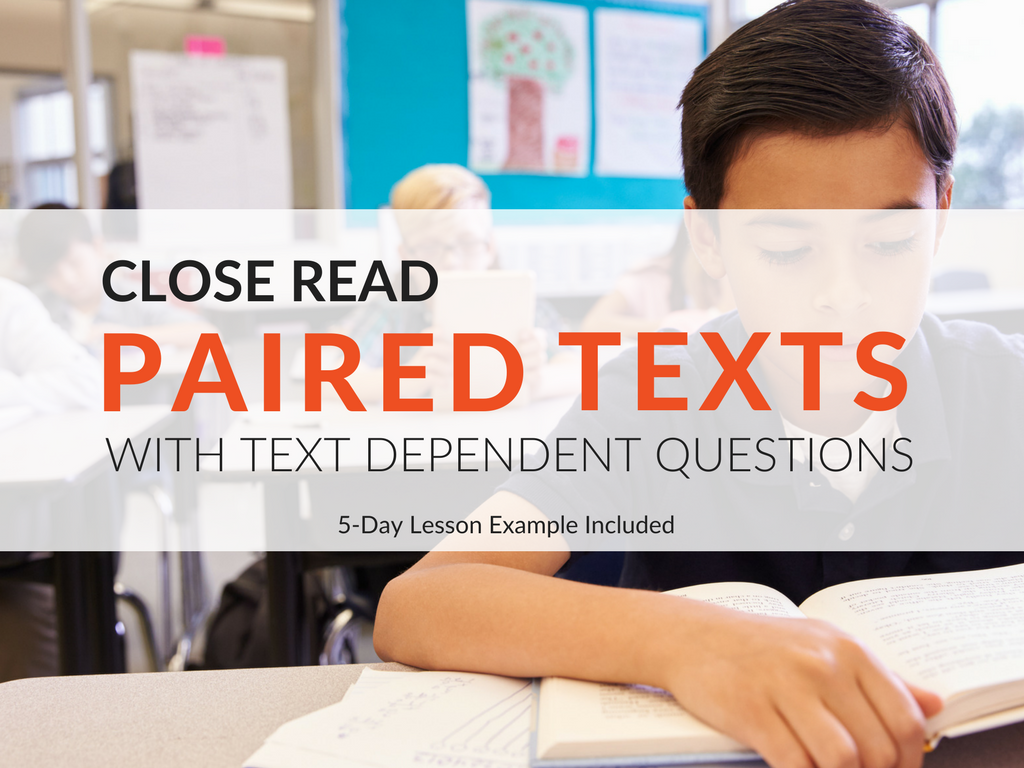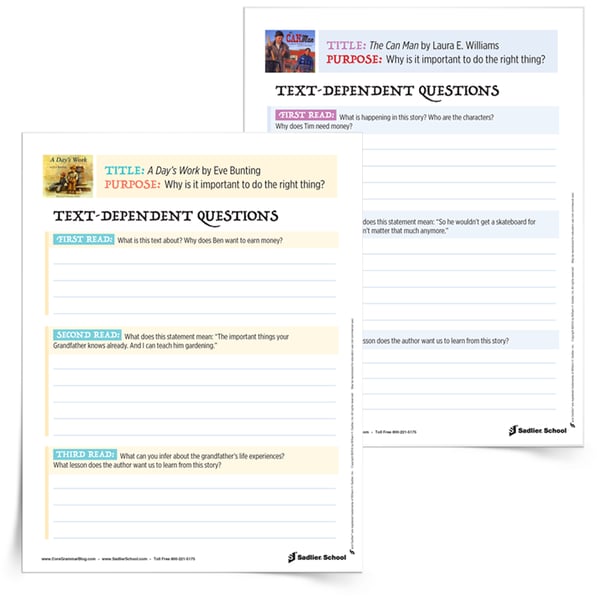May 24, 2018 ELA K-5, ELA Focus - Reading, ELA Focus - Close Reading, ELA Resources - Activities
Text-Dependent Questions for Close Reading of Paired Texts – 5 Day Lesson Plan
By: Erin Lynch
In close reading, it is important to compare texts with similar purpose, point of view, or other specific aspects. The more specific the comparison being made and the greater the variety of texts, the more useful it is for helping students develop reading and writing skills. One way of comparing texts is to have students answer text-dependent questions for each text, followed by text-dependent questions comparing the two texts.
Thinking about and answering text-dependent questions can take students to a deeper level of understanding the texts. In this article, you’ll learn how to create text-dependent questions for comparing two texts and you’ll see what close reading lessons look like when implemented. Download a set of text-dependent questions for A Day's Work by Eve Bunting and The Can Man by Laura E. Williams to use with your students.
Often, my best lessons are inspired by other teachers. Two of my favorite teachers to “talk shop” with are my mother-in-law Peggy (a Grade 4 teacher) and my sister-in-law Shannon (a Grade 5 reading teacher). Recently, Shannon recommended the book The Can Man by Laura E. Williams. What a fantastic book! As soon as I finished reading, I immediately began thinking about the most purposeful way to utilize the book. Then it hit me! The Can Man reminded me of one of my favorite Eve Bunting books, A Day's Work. I began connecting the main characters (two boys that are similar in age), who work hard to earn some money. Their reasons for earning the money are very different, but their determination is the same.
Once I made these connections I decided to create a series of lessons comparing the texts with text- dependent questions.
Before going deeper into the lessons, here is a brief synopsis of both books, in case you are unfamiliar with them.
A Day's Work by Eve Bunting
Francisco is trying to find work for himself and his grandfather (who has just arrived from Mexico and speaks no English). Ben is looking to hire someone to help with a gardening project. Francisco assures Ben that his grandfather is a “fine gardener,” which is not true (his grandfather was a carpenter). At the end of the day, Ben returns and is shocked to see that Francisco and his grandfather have removed all the plants and left the weeds. Ben decides to give Francisco and his grandfather the opportunity to do the job again correctly, and Francisco learns an important lesson about being truthful.
The Can Man by Laura E. Williams
Tim's birthday is just a week away, and more than anything he wants a skateboard. But money is tight, and Tim knows his family cannot afford to buy him a board. As Tim ponders how he might earn money for a skateboard, he hears The Can Man down the street collecting empty soft drink cans. The clang of the cans in the homeless man's cart gives Tim an idea. He will collect cans too, and cash them in for the redemption money. By the end of the week, Tim has almost reached his goal—until a couple of chance encounters with The Can Man change everything.
Planning Text-Dependent Questions for Multiple Texts
I started lesson planning by creating text-dependent questions for both books. I wanted similar questions for both books, and then created additional questions that would tie the books together.
First, I needed to ask a general question to be sure that students understood the gist of both texts. Then, I wanted to give students a question that would lead them to analyze an excerpt from the text, digging deeper into the author's craft and use of language. Finally, I wanted to ask text-dependent questions that would encourage students to use critical thinking skills, such as drawing conclusions and making inferences.
These text-dependent questions sparked excellent discussions among students when they were in small groups and when they worked as a whole class. The questions for both books are available for download.
Series of Lessons Comparing Texts with Text-Dependent Questions
DAY 1
First Read of A Day’s Work by Eve Bunting
Before the first read, we discussed what it might be like to come to this country and not know the language. We brainstormed various obstacles that person might face. I gave students a purpose for reading by asking them to find out what is happening in this story.
During the first read, I would pause periodically to ask a scaffold question such as, “Who are the people the text is focused on?”
After the first read, I had students independently complete the text-dependent questions for A Day's Work by Eve Bunting. Students then shared their answers in small groups or as a class, in order to extend their thinking by listening to the thoughts of their peers.
DAY 2
Second and Third Read of A Day’s Work by Eve Bunting
Before the second read, I gave students the purpose for reading, saying, “We are going to reread parts of the text to learn how the text structure conveys meaning.”
During the second read, I asked text-dependent questions such as, “How do the illustrations help support the story? What kinds of details support the major ideas?”
Before the third read, I told students that the purpose for this third read is to make inferences about what it was like to travel long distance to another country as an immigrant.
During the third read, I used scaffolded question to keep students thinking about the purpose. I gave them text-dependent questions that helped them make inferences, such as, “What can you infer about the grandfather’s experience? What lessons can be learned from reading this text?”
DAY 3
First Read of The Can Man by Laura E. Williams
Before the first read, we discussed what it might be like to be homeless. We brainstormed various obstacles that a homeless person might face. I gave students a purpose for reading by asking them to find out what is happening in this story.
During the first read, I paused to ask scaffolded text-dependent questions such as, “What is happening in this story? Who are the characters? Why does Tim need money?”
After the first read, I had students independently complete text-dependent questions for The Can Man by Laura E. Williams. Students then shared their answers in small groups or as a class, in order to extend their thinking by listening to the thoughts of their peers.
DAY 4
Second and Third Read of The Can Man by Laura E. Williams
Before the second read, I gave students the purpose for reading, saying, “We are going to reread parts of the text to learn how the text structure conveys meaning.”
During the second read, I asked text-dependent questions such as, “What information does the author give in order to let you know The Can Man is in need of money?”
Before the third read, I told students the purpose for this third read is to make inferences about what it was like to be homeless and not have the basics for living.
During the third read, I used scaffolded questions to keep students thinking about the purpose. I gave them text-dependent questions that helped them make inferences, such as, “What can you infer about the Mr. Peter’s life experiences? What lessons can be learned from reading this text?”
DAY 5
Intertextual Analysis
Having read both texts and answering the related text-dependent questions, students were ready to dive deeper into intertextual analysis!
We began the final day of lessons by comparing and contrasting the two books, as a class, using a T-chart.
To finish, students wrote an essay about which book they thought was more powerful. Once students completed their essays, the class discussed and debated which book was more powerful.
In Conclusion
Text-dependent questions are an important part of supporting students in developing a high level of comprehension about a text. Comparing texts with similar topics and purposes can take students to a deeper level of understanding. Remember, when you create text-dependent questions they should be thoughtfully prepared and written at an appropriate level so that they challenge the reader to understand the text in the most meaningful way possible. The lesson ideas shared with you in this post today meet this requirement.
Don't delay—download a set of text-dependent questions for A Day's Work by Eve Bunting and The Can Man by Laura E. Williams to use with your students. The lessons that both books teach will leave a lasting impact on your students.
Common Core State Standards
Key Ideas and Details:
CCSS.ELA-Literacy.CCRA.R.1
Read closely to determine what the text says explicitly and to make logical inferences from it; cite specific textual evidence when writing or speaking to support conclusions drawn from the text.
CCSS.ELA-Literacy.CCRA.R.2
Determine central ideas or themes of a text and analyze their development; summarize the key supporting details and ideas.
CCSS.ELA-Literacy.CCRA.R.3
Analyze how and why individuals, events, or ideas develop and interact over the course of a text.
Craft and Structure:
CCSS.ELA-Literacy.CCRA.R.4
Interpret words and phrases as they are used in a text, including determining technical, connotative, and figurative meanings, and analyze how specific word choices shape meaning or tone.





